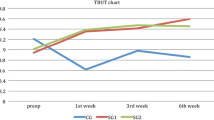Abstract
The purpose of this study was to evaluate if administration of artificial tears of high or low-viscosity improve cataract patients’ satisfaction and postoperative pain after cataract surgery. Thirty consecutive patients undergoing bilateral cataract surgery under topical anesthesia were enrolled prospectively. Administration of the following postoperative therapies was randomized: for all participants, one eye was treated with “instant vision” (IV) therapy alone (IV-alone), i.e., this eye remained uncovered. In group 1 (n = 11), the second eye received IV therapy with Hylo-Comod® (HC) eye drops; in group 2 (n = 9), IV with Vidisic® (VS) eye drops; in group 3 (n = 10), an ointment bandage (OB). Postoperative satisfaction, pain scores, visual acuity, intraocular pressure, tear break-up time and postoperative corneal changes were compared. Group 1: No clear preference was observed for any of the methods concerning subjective satisfaction. Group 2: 100% of patients preferred IV + VS therapy. Group 3: Patients’ postoperative satisfaction with OB therapy was 89%. Concerning postoperative pain perception, no significant differences were found between IV therapy alone and the IV-combination therapies. Significant differences in pain perception (P < 0.042) were measured between IV and OB in the first 8 h postoperatively. Ten hours postoperatively and beyond, there were no significant differences in pain scores (P > 0.05). Pain perception was significantly lower with OB when compared to IV-alone or IV-combination therapies using artificial tears. This result was verified by OB’s 89% patient satisfaction level. Low-viscosity artificial tears showed no significant subjective benefits for the patients; patient satisfaction was greatest (100%) with a high-viscosity tear substitute.

Similar content being viewed by others
References
Weindler J, Weindler M, Ruprecht KW (2004) Lokalanästhesie in der ophthalmochirurgie. Ophthalmologe 101:847–865
Laws DE, Watts MT, Kirkby GR, Lawson J (1989) Is padding necessary after cataract extraction? Br J Ophthalmol 73:699–701
Carpel EF (1990) The use of eye pads after cataract surgery. Am J Ophthalmol 110:318–319
Shigero H (2004) Effect of eye patching on postoperative inflammation after cataract surgery. J Cataract Refract Surg 30:273–274
Bainbridge JW, Smith JM, Reddy G, Kirwan JF (1998) Is eye padding routinely necessary after uncomplicated phacoemulsification? Eye 12:637–640
Mayer S, Wirbelauer C, Häberle H, Altmeyer M, Pham DT (2005) Zur notwendigkeit eines augenverbandes nach kataraktoperation in tropfanaesthesie. Klein Monatsbl Augenheilkd 222:41–45 Georg Thieme Verlag KG Stuttgart New York
Stifter E, Menapace R (2007) “Instant vision” compared with postoperative patching: clinical evaluation and patient satisfaction after bilateral cataract surgery. Am J Ophthalmol 143(3):441–448
Marquardt R (1986) Die behandlung des trockenen auges mit einem neuen tropfähnlichen gel. Klin Mbl Augenheilk 189:51–54
Christ T, Marquardt R (1987) Zur anwendung eines neuen gelartigen tränenersatzmittels in ophthalmologie und intensivmedizin. Fortschr Ophthalmol 84:335–339
Davison JA (2003) Clinical application of the lens opacities classification system III in the performance of phacoemulsification, J Cataract Refract Surg 29(1):138–145
DeLoach LJ, Higgins MS, Caplan AB, Stiff JL (1198) The visual analog scale in the immediate postoperative period: intrasubject variability and correlation with a numeric scale. Anesth Analg 86:102–106
Bron AJ, Daubas P, Siou-Mermet R, Trinquand C (1998) Comparison of the efficacy and safety of two eye gels in the treatment of dry eyes: lacrinorm and viscotears. Eye 12(Pt 5):839–847
Werner L, Sher JH, Taylor JR, Mamalis N, Nash WA, Csordas JE, Green G, Maziarz EP, Liu XM (2006) Toxic anterior segment syndrome and possible association with ointment in the anterior chamber following cataract surgery. J Cataract Refract Surg 32(2):227–235
Conflict of interest
None to declare.
Author information
Authors and Affiliations
Corresponding author
Rights and permissions
About this article
Cite this article
Sipos, E., Stifter, E. & Menapace, R. Patient satisfaction and postoperative pain with different postoperative therapy regimens after standardized cataract surgery: a randomized intraindividual comparison. Int Ophthalmol 31, 453–460 (2011). https://doi.org/10.1007/s10792-011-9497-x
Received:
Accepted:
Published:
Issue Date:
DOI: https://doi.org/10.1007/s10792-011-9497-x




